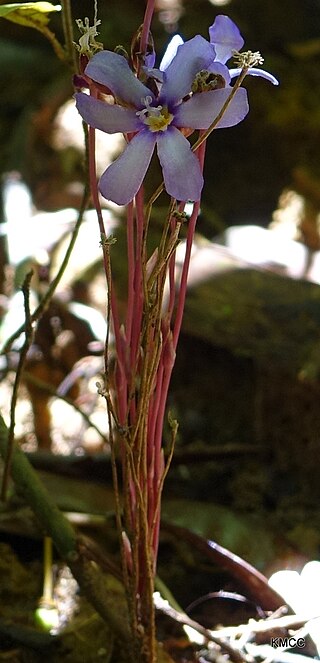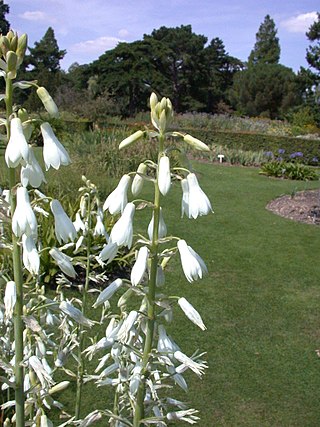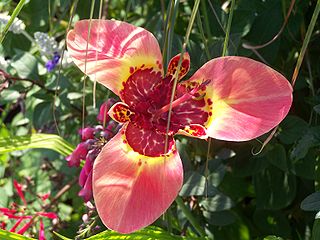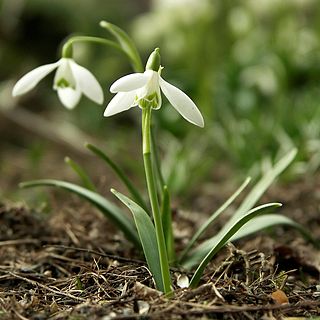
Asparagales is an order of plants in modern classification systems such as the Angiosperm Phylogeny Group (APG) and the Angiosperm Phylogeny Web. The order takes its name from the type family Asparagaceae and is placed in the monocots amongst the lilioid monocots. The order has only recently been recognized in classification systems. It was first put forward by Huber in 1977 and later taken up in the Dahlgren system of 1985 and then the APG in 1998, 2003 and 2009. Before this, many of its families were assigned to the old order Liliales, a very large order containing almost all monocots with colorful tepals and lacking starch in their endosperm. DNA sequence analysis indicated that many of the taxa previously included in Liliales should actually be redistributed over three orders, Liliales, Asparagales, and Dioscoreales. The boundaries of the Asparagales and of its families have undergone a series of changes in recent years; future research may lead to further changes and ultimately greater stability. In the APG circumscription, Asparagales is the largest order of monocots with 14 families, 1,122 genera, and about 36,000 species.

Iridaceae is a family of plants in order Asparagales, taking its name from the irises. It has a nearly global distribution, with 69 accepted genera with a total of c. 2500 species. It includes a number of economically important cultivated plants, such as species of Freesia, Gladiolus, and Crocus, as well as the crop saffron.

Asphodeloideae is a subfamily of the monocot family Asphodelaceae in the order Asparagales. It has previously been treated as a separate family, Asphodelaceae sensu stricto. The family Asphodelaceae has now been proposed to be a nomen conservandum, and the proposal has been recommended for ratification in 2017. In that case, Asphodelaceae will have priority over Xanthorrhoeaceae. This is reflected in the APG IV family lists.

Geosiris is a genus in the flowering plant family Iridaceae, first described in 1894. It was thought for many years to contain only one species, Geosiris aphylla, endemic to Madagascar. But then in 2010, a second species was described, Geosiris albiflora, from Mayotte Island in the Indian Ocean northwest of Madagascar. In 2017, a third species was found in Queensland, Australia, Geosiris australiensisB.Gray & Y.W.Low.

Ornithogalum is a genus of perennial plants mostly native to southern Europe and southern Africa belonging to the family Asparagaceae. Some species are native to other areas such as the Caucasus. Growing from a bulb, species have linear basal leaves and a slender stalk, up to 30 cm tall, bearing clusters of typically white star-shaped flowers, often striped with green. The common name of the genus, star-of-Bethlehem, is based on its star-shaped flowers, after the Star of Bethlehem that appears in the biblical account of the birth of Jesus. The number of species has varied considerably, depending on authority, from 50 to 300.

Galtonia is a genus of plants in the family Asparagaceae, subfamily Scilloideae. Native to Southern Africa, the genus is named after Sir Francis Galton. According to some authorities it has been subsumed into Ornithogalum as a subgenus, while others prefer to keep it as a separate genus.

Aristea is a genus of evergreen, perennial and rhizomatous species of flowering plants in the family Iridaceae, first described in 1789. The genus is distributed in tropical and southern Africa, as well as Madagascar. The genus name is derived from the Greek word arista, meaning "awn".

Tigridieae is a tribe of plants in the subfamily Iridoideae and included in the family Iridaceae. It contains many perennials which have cormous rootstocks. The name of the tribe comes from its main genus - Tigridia. The tribe is native to the New World.

Crocoideae is one of the major subfamilies in the family Iridaceae.

Irideae is a tribe included in the well-known family Iridaceae. It contains many species in five genera which are widely distributed in the Old World. The tribe derives its name from Iris, which is the largest genus of the tribe.

Trimezieae is a tribe included in the subfamily Iridoideae of the family Iridaceae. It is the smallest tribe in this subfamily, containing only three closely related genera.

Watsonieae is the second largest tribe in the subfamily Crocoideae and named after the best-known genus in it — Watsonia. The members in this group are widely distributed in Africa, mainly in its southern parts.

Sisyrinchieae is the second largest tribe in the subfamily Iridoideae. The group is included in the family Iridaceae. It contains many perennials which are widely distributed in the New World.
Zygotritonia is a genus of herbaceous, perennial and bulbous plants in the family Iridaceae. It contains four species distributed throughout sub-Saharan Africa. The genus name is derived from the word zygomorphic, and the apparent resemblance to some species in the genus Tritonia.

Nivenia is a genus of flowering plants in the family Iridaceae first described as a genus in 1808. Species in the genus are restricted in distribution to an area in the Cape Province of South Africa.

Miriam Phoebe de Vos was a leading South African botanist and academic. She was an expert on bulbous plants, especially Romulea. She also had a special interest in Moraea and Clivia.
Alan W. Meerow is an American botanist, born in New York City in 1952. He specializes in the taxonomy of the family Amaryllidaceae and the horticulture of palms and tropical ornamental plants. He also works on the population genetics and molecular systematics of cycads and palms.

Iris tuberosa is a species of tuberous flowering plant of the genus Iris, with the common names snake's-head, snake's-head iris, widow iris, black iris, or velvet flower-de-luce.

Galantheae is a tribe of European, West Asian and North African flowering plants belonging to the subfamily Amaryllidoideae of the Amaryllis family (Amaryllidaceae). As of 2017, it contains three genera, although more were included previously. The position of the ovary is inferior.
Peter Goldblatt is a South African botanist, working principally in the United States.

















